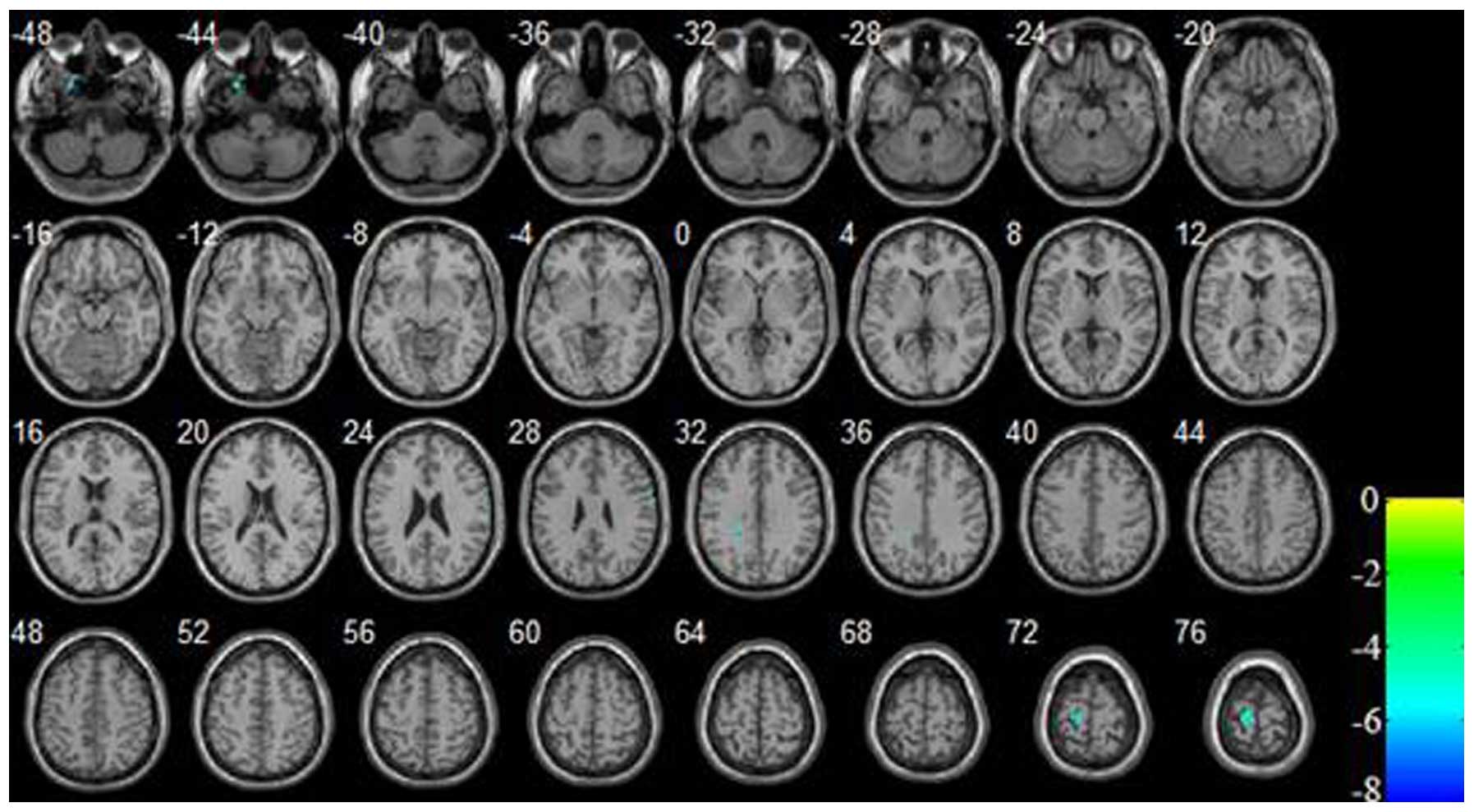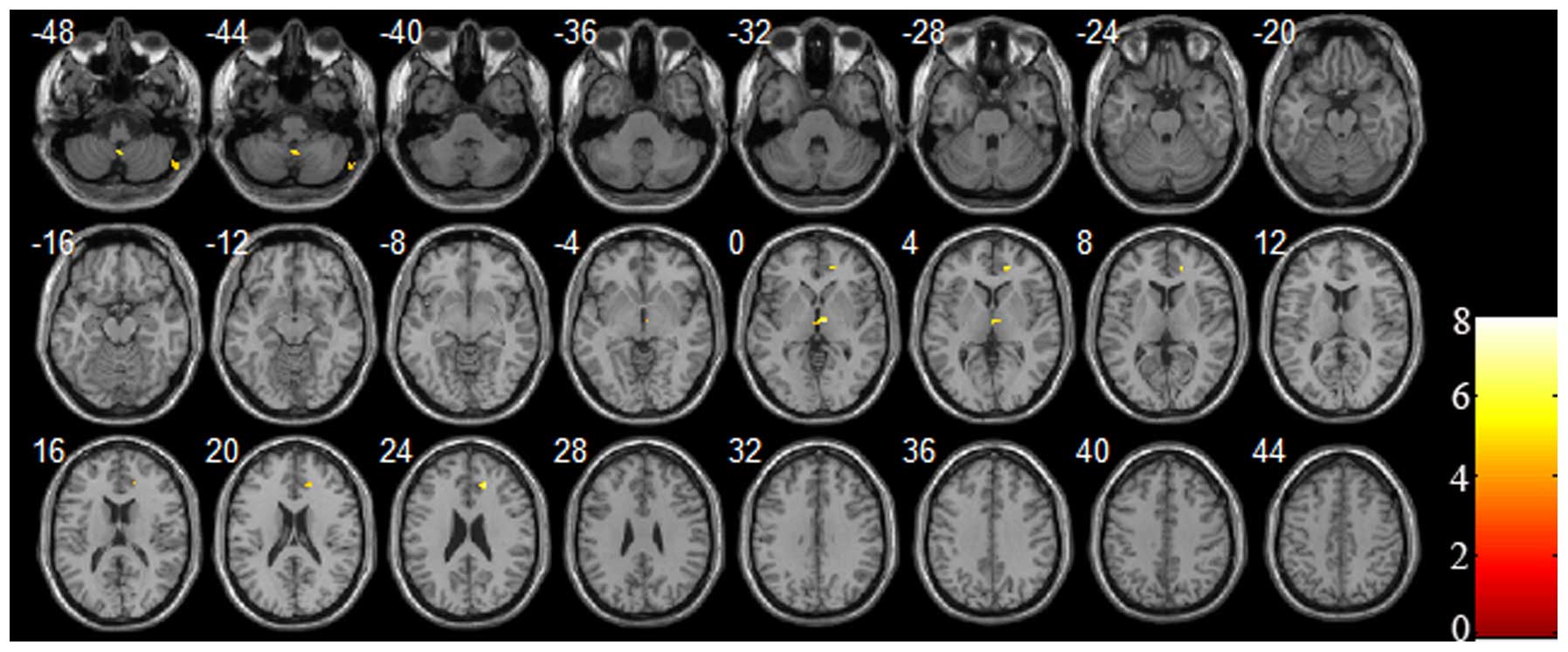|
1
|
Saltiel PF and Silvershein DI: Major
depressive disorder: Mechanism-based prescribing for personalized
medicine. Neuropsychiatr Dis Treat. 11:875–888. 2015.PubMed/NCBI
|
|
2
|
Drevets WC: Neuroimaging studies of mood
disorders. Biol Psychiatry. 48:813–829. 2000. View Article : Google Scholar : PubMed/NCBI
|
|
3
|
Ho TC, Wu J, Shin DD, Liu TT, Tapert SF,
Yang G, Connolly CG, Frank GK, Max JE, Wolkowitz O, et al: Altered
cerebral perfusion in executive, affective, and motor networks
during adolescent depression. J Am Acad Child Adolesc Psychiatry.
52:1076–1091.e2. 2013. View Article : Google Scholar : PubMed/NCBI
|
|
4
|
Wang DJ, Chen Y, Fernández-Seara MA and
Detre JA: Potentials and challenges for arterial spin labeling in
pharmacological magnetic resonance imaging. J Pharmacol Exp Ther.
337:359–366. 2011. View Article : Google Scholar : PubMed/NCBI
|
|
5
|
Hartkamp NS, Petersen ET, De Vis JB,
Bokkers RP and Hendrikse J: Mapping of cerebral perfusion
territories using territorial arterial spin labeling: Techniques
and clinical application. NMR Biomed. 26:901–912. 2013. View Article : Google Scholar : PubMed/NCBI
|
|
6
|
Järnum H, Eskildsen SF, Steffensen EG,
Lundbye-Christensen S, Simonsen CW, Thomsen IS, Fründ ET, Théberge
J and Larsson EM: Longitudinal MRI study of cortical thickness,
perfusion, and metabolite levels in major depressive disorder. Acta
Psychiatr Scand. 124:435–446. 2011. View Article : Google Scholar : PubMed/NCBI
|
|
7
|
Ota M, Noda T, Sato N, Hattori K, Teraishi
T, Hori H, Nagashima A, Shimoji K, Higuchi T and Kunugi H:
Characteristic distributions of regional cerebral blood flow
changes in major depressive disorder patients: A pseudo-continuous
arterial spin labeling (pCASL) study. J Affect Disord. 165:59–63.
2014. View Article : Google Scholar : PubMed/NCBI
|
|
8
|
Nobler MS, Olvet KR and Sackeim HA:
Effects of medications on cerebral blood flow in late-life
depression. Curr Psychiatry Rep. 4:51–58. 2002. View Article : Google Scholar : PubMed/NCBI
|
|
9
|
First MB, Spitzer RL, Gibbon M and
Williams JB: Structured Clinical Interview for DSM-IV Axis I
Disorders (SCID)Biometrics Research. New York State Psychiatric
Institute; New York, NY: 1996
|
|
10
|
Hamilton M: A rating scale for depression.
J Neurol Neurosurg Psychiatry. 23:56–62. 1960. View Article : Google Scholar : PubMed/NCBI
|
|
11
|
Alexopoulos GS, Kiosses DN, Heo M, Murphy
CF, Shanmugham B and Gunning-Dixon F: Executive dysfunction and the
course of geriatric depression. Biol Psychiatry. 58:204–210. 2005.
View Article : Google Scholar : PubMed/NCBI
|
|
12
|
Davies J, Lloyd KR, Jones IK, Barnes A and
Pilowsky LS: Changes in regional cerebral blood flow with
venlafaxine in the treatment of major depression. Am J Psychiatry.
160:374–376. 2003. View Article : Google Scholar : PubMed/NCBI
|
|
13
|
Galynker II, Cai J, Ongseng F, Finestone
H, Dutta E and Serseni D: Hypofrontality and negative symptoms in
major depressive disorder. J Nucl Med. 39:608–612. 1998.PubMed/NCBI
|
|
14
|
Wang Y, Zhang H, Tang S, Liu X, O'Neil A,
Turner A, Chai F, Chen F and Berk M: Assessing regional cerebral
blood flow in depression using 320-slice computed tomography. PLoS
One. 9:e1077352014. View Article : Google Scholar : PubMed/NCBI
|
|
15
|
Blackhart GC, Minnix JA and Kline JP: Can
EEG asymmetry patterns predict future development of anxiety and
depression? A preliminary study. Biol Psychol. 72:46–50. 2006.
View Article : Google Scholar : PubMed/NCBI
|
|
16
|
Bruder GE, Quitkin FM, Stewart JW, Martin
C, Voglmaier MM and Harrison WM: Cerebral laterality and
depression: Differences in perceptual asymmetry among diagnostic
subtypes. J Abnorm Psychol. 98:177–186. 1989. View Article : Google Scholar : PubMed/NCBI
|
|
17
|
Hannesdóttir DK, Doxie J, Bell MA,
Ollendick TH and Wolfe CD: A longitudinal study of emotion
regulation and anxiety in middle childhood: Associations with
frontal EEG asymmetry in early childhood. Dev Psychobiol.
52:197–204. 2010.PubMed/NCBI
|
|
18
|
Kemp AH, Cooper NJ, Hermens G, Gordon E,
Bryant R and Williams LM: Toward an integrated profile of emotional
intelligence: Introducing a brief measure. J Integr Neurosci.
4:41–61. 2005. View Article : Google Scholar : PubMed/NCBI
|
|
19
|
Liu H, Yin HF, Wu DX and Xu SJ:
Event-related potentials in response to emotional words in patients
with major depressive disorder and healthy controls.
Neuropsychobiology. 70:36–43. 2014. View Article : Google Scholar : PubMed/NCBI
|
|
20
|
Quraan MA, Protzner AB, Daskalakis ZJ,
Giacobbe P, Tang CW, Kennedy SH, Lozano AM and McAndrews MP: EEG
power asymmetry and functional connectivity as a marker of
treatment effectiveness in DBS surgery for depression.
Neuropsychopharmacology. 39:1270–1281. 2014. View Article : Google Scholar : PubMed/NCBI
|
|
21
|
Sundermann B, Olde Lütke Beverborg M and
Pfleiderer B: Toward literature-based feature selection for
diagnostic classification: A meta-analysis of resting-state fMRI in
depression. Front Hum Neurosci. 8:6922014. View Article : Google Scholar : PubMed/NCBI
|
|
22
|
Moretti DV, Prestia A, Binetti G, Zanetti
O and Frisoni GB: Increase of theta frequency is associated with
reduction in regional cerebral blood flow only in subjects with
mild cognitive impairment with higher upper alpha/low alpha EEG
frequency power ratio. Front Behav Neurosci. 7:1882013. View Article : Google Scholar : PubMed/NCBI
|
|
23
|
Lui S, Parkes LM, Huang X, Zou K, Chan RC,
Yang H, Zou L, Li D, Tang H, Zhang T, et al: Depressive disorders:
Focally altered cerebral perfusion measured with arterial
spin-labeling MR imaging. Radiology. 251:476–484. 2009. View Article : Google Scholar : PubMed/NCBI
|
|
24
|
Smith DJ and Cavanagh JT: The use of
single photon emission computed tomography in depressive disorders.
Nucl Med Commun. 26:197–203. 2005. View Article : Google Scholar : PubMed/NCBI
|
|
25
|
Vasic N, Wolf ND, Grön G, Sosic-Vasic Z,
Connemann BJ, Sambataro F, von Strombeck A, Lang D, Otte S, Dudek
M, et al: Baseline brain perfusion and brain structure in patients
with major depression: A multimodal magnetic resonance imaging
study. J Psychiatry Neurosci. 40:412–421. 2015. View Article : Google Scholar : PubMed/NCBI
|
|
26
|
Patrick KS, Corbin TR and Murphy CE:
Ethylphenidate as a selective dopaminergic agonist and
methylphenidate-ethanol transesterification biomarker. J Pharm Sci.
103:3834–3842. 2014. View Article : Google Scholar : PubMed/NCBI
|












